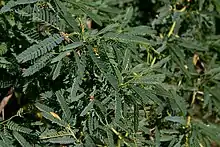Vachellia jacquemontii
Vachellia jacquemontii is a species of plant native to the Thar Desert of India. The species name refers to French botanist Victor Jacquemont.[2] It is an erect shrub usually 6 feet (1.8 m) to 10 feet (3.0 m) high, with multiple shoots coming from below ground. It commonly grows on dry sandy soils. It is very hardy, being capable of standing extremes of temperature and excessive drought. It is frost-hardy and coppices well. It is a fodder plant along with Ziziphus nummularia, which occurs in association with it.
| Vachellia jacquemontii | |
|---|---|
 | |
| Scientific classification | |
| Kingdom: | Plantae |
| Clade: | Tracheophytes |
| Clade: | Angiosperms |
| Clade: | Eudicots |
| Clade: | Rosids |
| Order: | Fabales |
| Family: | Fabaceae |
| Clade: | Mimosoideae |
| Genus: | Vachellia |
| Species: | V. jacquemontii |
| Binomial name | |
| Vachellia jacquemontii | |
| Synonyms[1] | |
| |
This plant has a number of traditional medicinal uses, including treatment of snakebite, induction of abortion, and for chronic renal disease.[3]
This shrub also plays an important role in stabilizing the sand dunes of its native desert habitat.[3] The wood is valuable as firewood because it produces a large amount of heat.[3] The branches are used in construction of huts and fences and the sturdy roots are used as rope.[3]
See also
Notes
- "Vachellia jacquemontii". Plants of the World Online. Royal Botanic Gardens, Kew. Retrieved 27 July 2020.
- Allen J. Coombes The A to Z of Plant Names: A Quick Reference Guide to 4000 Garden Plants, p. 50, at Google Books
- Choudhary, K., et al. (2009).Ethnobotany of Acacia jacquemontii Benth.—An Uncharted Tree of Thar Desert, Rajasthan, India. Archived November 22, 2010, at the Wayback Machine Ethnobotanical Leaflets 13 668-78.
References
- L R Burdak (1982): Recent advances in desert afforestation, Dehradun
- R C Ghosh (1977): Hand book on afforestation techniques, Dehradun.
- R K Gupta & Ishwar Prakasah (1975): Environmental analysis of the Thar Desert, Dehradun.
- R N Kaul (1963): Need for afforestation in the arid zones of India, LA-YAARAN, Vol 13